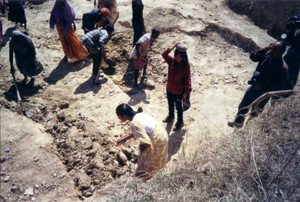Water Conservation, Irrigation and Land Improvement

Villagers digging up earth for a water storage structure

A structure full of water
The Ashram has laid special focus on farming since its inception. From 1969 to 1975, land improvement and bunding were taken up on a mass scale, under the project ‘Food for Work’. The project benefited 800 farmers, as their 1,200 acres of land had improved by constructing 30 community bunds and 350 small individual bunds. This led to the availability of water with which paddy cultivation in low lying areas could be done. Another benefit of this project was that people got work during difficult days. This enabled the people to come out of the clutches of moneylenders and, as a result, exploitation was reduced. In the famine of 1979-80, the Ashram undertook bunding and well digging for providing relief to the locals. The Ashram also motivated the government to undertake this work on a mass scale and helped the government in preparing earthen dam designs.
This work generated development zeal among the villagers. After 1975, 105 community and 926 small bunds were constructed. Total land improved is 23,186 acres. Irrigation was done through rehat and pumps. On an average, 4 acres of land was irrigated per irrigation structure, benefiting an average 3 farmers per irrigation structure.
Another feature of this project was the construction of irrigation towers, to create pressure at the pumping point. This helped to lift water to high lands for irrigation. This tower technique was first tested in the year 1976 and by 2000, 369 irrigation towers were constructed. The government constructed 150 irrigation towers. Now the panchayats also have adopted this technique for development of agriculture.
From 1975 to 1985, the Ashram bore the costs of implementation of this irrigation scheme. In the year 1986, it was decided that the beneficiary families would bear 50 per cent of the costs, in kind. In the year 1986, a labour bank scheme was introduced. Under this scheme, the beneficiary was to be paid 50 per cent of his and his helpers’ labour wages. It was expected that the beneficiary would pay his helper either through barter or if not possible then in cash. Since then this has become a custom.
Dry land development was a problem and a solution was found to it in 1967. Trenches were dug to store rain water on slopes. So far 269 acres of land, belonging to 210 farmers, that could not be irrigated and were infertile, were developed the new way. This was successful and cheap also. Hundreds of farmers did this, without taking any help from the Ashram. Most of the people started farming on this land, while some planted saplings. It is hoped that more people will adopt this technique.
